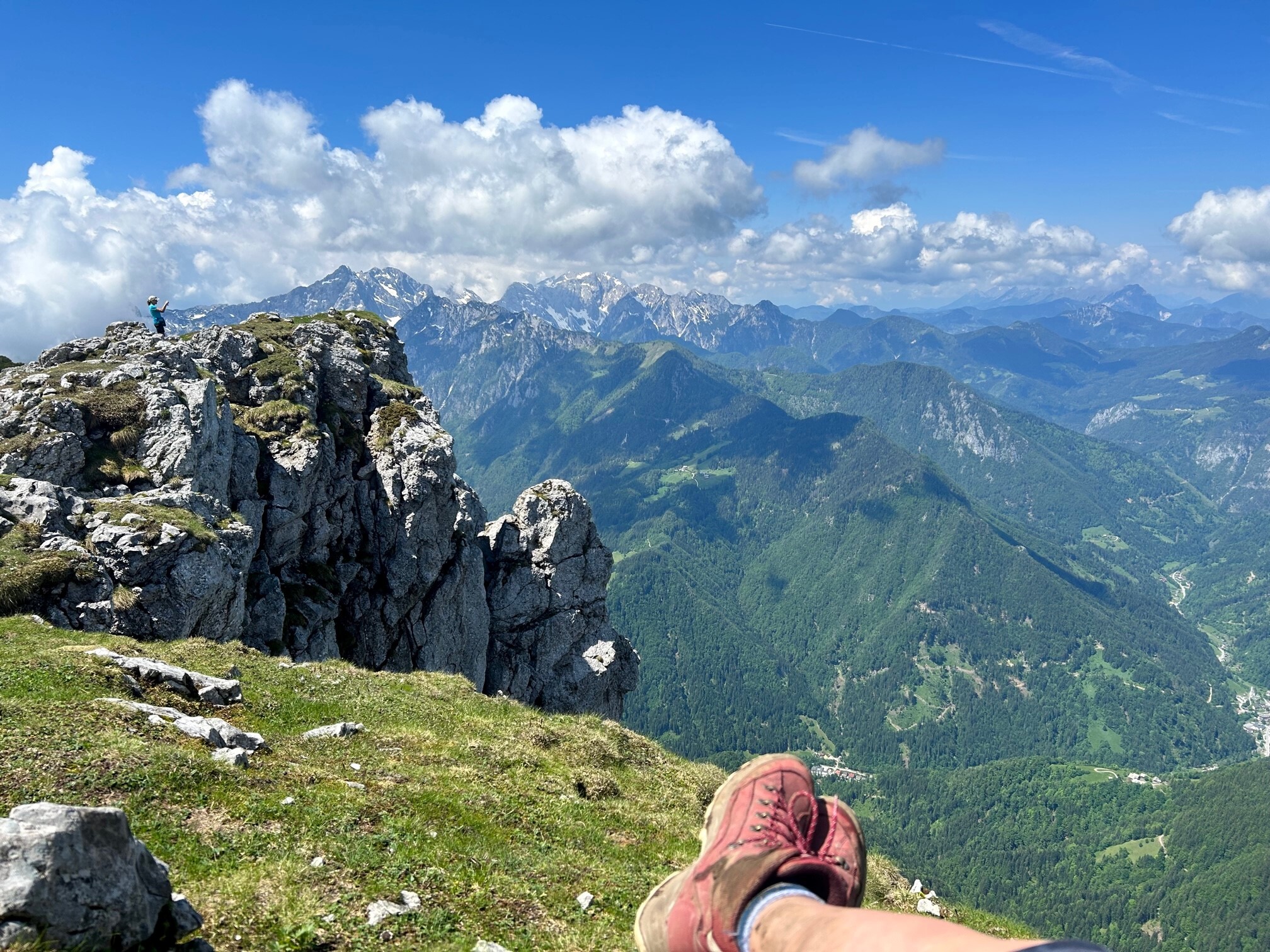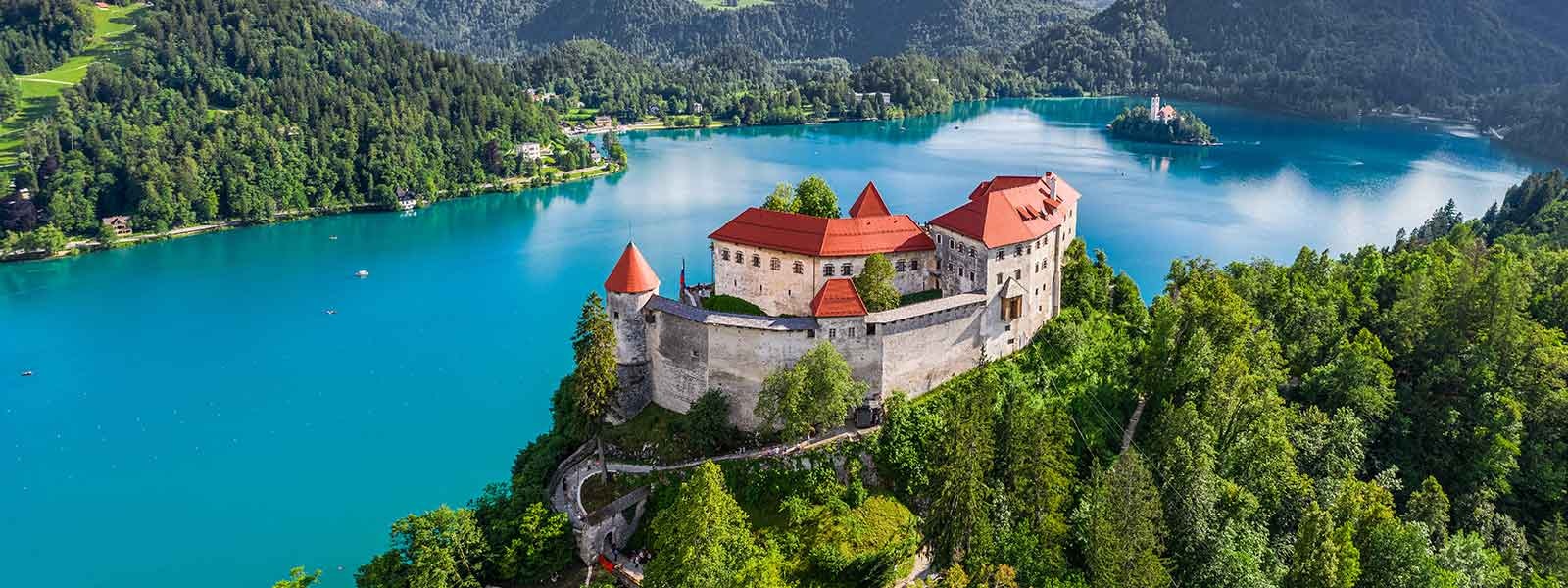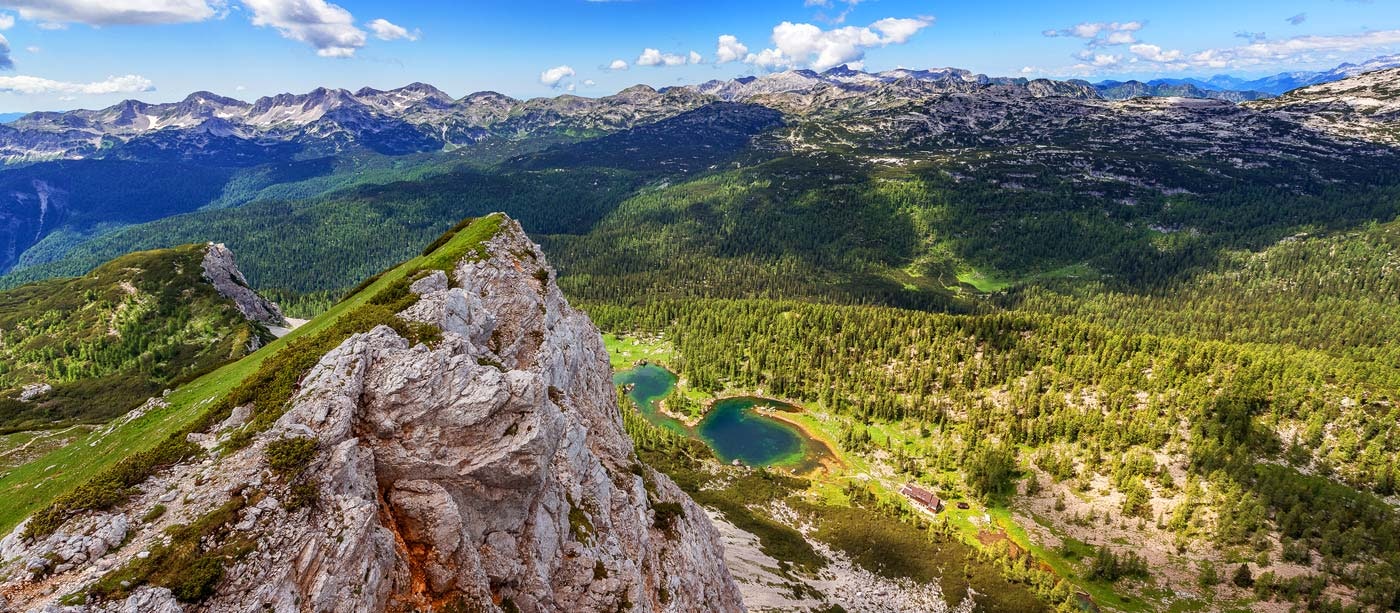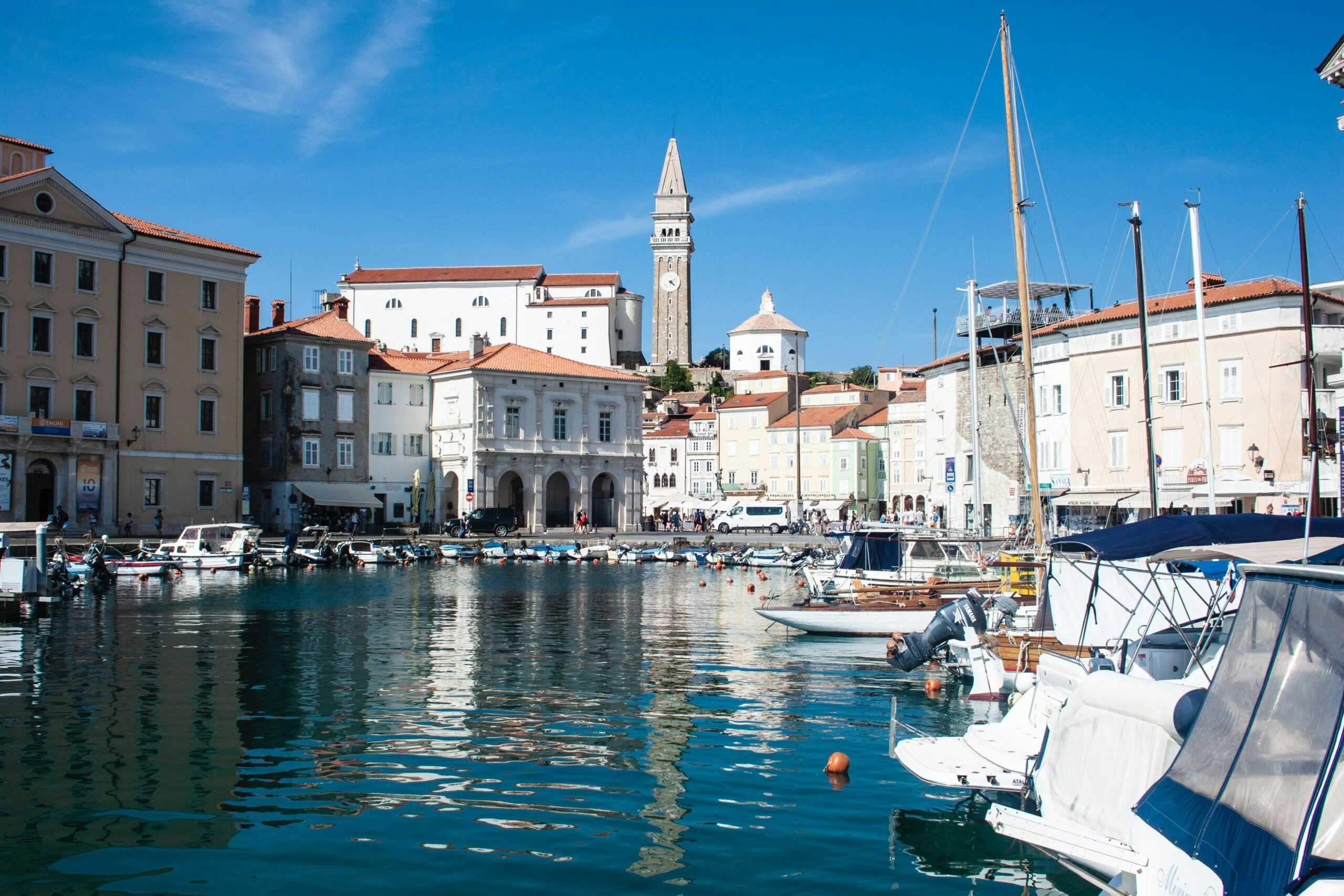Discover Slovenia
Slovenia is a small country located in the southern part of Central Europe, bordered by Austria, Italy, Croatia, and Hungary and once part of the former Yugoslavia. This landlocked nation is known for its stunning landscape of mountains, caves, lakes, and rivers, and offers visitors a wealth of natural beauty and unique experiences. The Julian Alps, located in the northwest of Slovenia and the eastern part of the larger Alps range, are home to some of the most breathtaking views in Europe. Also up north are Lake Bled and Lake Bohinj, two very popular recreational lakes, while the southern region is home to the Kras region, an area with caves and underground rivers.
Hikers will enjoy the less crowded hiking trails and pristine mountain lakes the country offers but might want to mix things up with a city experience. The capital, Ljubljana, is a vibrant and modern city, with picturesque streets and a lively cultural scene. Slovenia also has a rich cultural history, with many historic towns and villages that offer visitors a glimpse into the country’s past.
Planning a trip to Slovenia? Read on to find out when to visit, what to do, and more to make your vacation unforgettable.
What is the best time to visit Slovenia?
For such a small country, Slovenia offers plenty of experiences year-round. Around late May is when the country warms up and when travelers begin arriving, with the June—September months bringing beautiful sunny days, and when active adventures are on everyone’s agenda. If traveling to the coast or to the lakes, this summer period is when the crowds are the largest, but visiting in September is ideal, when tourism slows down and operators are still in business. In winter, a lot of operators close up, but if looking for alpine skiing, December—March is when the snow is at its peak, making ski conditions ideal.
How to get to Slovenia?
From the mainland United States, travelers will need to first fly into a major European city like London or Paris and then connect with another flight into Slovenia’s main airport, Ljubljana Jože Pučnik Airport.
How to get around Slovenia?
The most convenient way to get around Slovenia is by car. There are plenty of rental car companies to choose from, and the roads are generally in good condition. Public transportation is also available, with buses and trains running to most major cities. Buses will take travelers to more off-the-beaten track villages while Slovene Railways offers ideal train travel between major cities. Cyclists will enjoy the accessible biking routes the country offers, including the Alps to the Adriatic Bike Slovenia Green route and the Slovenia Green Gourmet route, which starts and ends in Ljubljana, visiting some of the country’s main sites along the way.
Do I need a visa to visit Slovenia?
US citizens do not need a visa for stays up to 90 days. Citizens of other countries should check with their local embassy for entry requirements.
How much time do I need in Slovenia?
Because Slovenia is a small country, most travelers will be able to see the main highlights in in 7-10 days. Travelers should plan on spending no less than a day in Ljubljana and Lake Bled, adding time as needed for longer hiking adventures and outdoor exploration.
What are the top 5 places to visit in Slovenia?
1. Ljubljana
The capital city of Ljubljana is full of stories. Travelers will want to spend time at Ljubljana Castle, a 16th-century castle that sits 1,200 feet high on Castle Hill overlooking the town. The most scenic way to visit the castle is via the 230-foot-long funicular that starts in the city’s Old Town, but you can also take a train or one of the walking trails up to the castle. At the castle, visitors can explore at their leisure—with the castle’s watchtower a highlight, as well as museums, towers, chapels, and gates. The city’s Old Town hosts some significant sites and is also the city’s most picturesque neighborhood. The Cathedral of Saint Nicholas with its Baroque architecture and embellishments can be found here as well as cobblestone squares with cafes and shops lining River Ljubljana. The city’s bridges are also worth checking out, especially Dragon Bridge with its sheet-copper dragons perched on its four corners; Butcher’s Bridge, where lovers have added padlocks symbolizing their love; and Triple Bridge, which was designed by Jože Plečnik, a Slovene architect who was primarily responsible for the city’s urban design. The city is also full of parks and gardens, including Tivoli Garden (the largest park in Slovenia), as well as open markets, street food, and contemporary Slovenian cuisine.
2. Julian Alps
Part of the larger Alps mountain chain, the 200-million-year-old Julian Alps take up an area that is 2,700 square miles and host Slovenia’s highest peak, Mount Triglav, at over 9,000 feet high. The area is known for its natural landscapes, hundreds of miles of hiking trails, skiing, and awe-inspiring views. Skiers will want to visit Kransjska Gora, an alpine resort recognized for its winter sports while hikers and adventure seekers will want to start in the country’s adventure capital, Bolvec. Headquartered in the Julian Alps, Bolvec is one of the best launching points for alpine hiking adventures. This River Sika valley town is full of outdoor activities including rafting, kayaking, exploring canyons and waterfalls, and the nearby ski resort of Kanin-Sella Nevea. The Trigav National Park also sits within the region, offering multiple hiking trails including its popular Juliana Trail, a 168-mile circuit trail made up of 16 stages that takes approximately 20 days to complete (you can hike stages of it, though). Along the route travelers will visit Lake Bohinj, the largest lake in Slovenia, as well as popular Lake Bled. Other trails worth exploring include the Slovenian Mountain Trail, the oldest and longest trail in the country at 383 miles, and the Walk of Peace, a 136-mile trail following the Soca Rover.
3. Lake Bled
Found in the Julian Alps, Lake Bled is Slovenia’s most popular tourist destination. The area is known for its charming, storybook alpine village, the lake’s vibrant turquoise color, and the Church of the Assumption on Bled Island, which is accessed by gondola or rowboat. Watching over the lake is Bled Castle, an 11th-century castle fortress with a Gothic chapel, museum, armory, and stunning views of the lake below. Nearby is Vintgar Gorge, surrounded by beech forests and steep slopes. Travelers can explore the gorge by walking its mile-long wooden walkway that leads to the country’s largest waterfall, Sum Falls, a 50-foot-high waterfall. Back in Bled, travelers can swim the lake, take a rafting or kayaking tour, or relax in the resort town’s cafes and restaurants between stops at local artisan shops.
4. Postojna Caves
About an hour outside Bled is the 80,000-foot-long Postojna Cave system, the most visited cave system in Europe and home to over 150 animal species. Visitors will marvel at its stalagmites and stalactites formations, massive cave chambers, and possibly encounter its most well-known resident, the olm, an aquatic salamander often dubbed “baby dragon.” Near the caves sits white-washed Predjama Castle, the world’s oldest cave castle that dates back 800 years (although its outside façade is from the 16th century, built on top of the original castle). Once the home of robber-baron and knight Erazem Lueger, the castle was the site of a siege that Lueger held for over a year. At the back of the castle are stairs that lead to a network of caves that connect to the larger Postojna cave system.
5. Portorož and Piran
Situated on the Adriatic coast, the resort towns of Portorož and Piran can be found. Once ruled by Venetian doges—you can daytrip to Venice from here—the towns are now known primarily for their seaside activities. Portorož is the more popular of the two towns, with luxury accommodations, restaurants, spas, casinos, and a vibrant nightlife. Its popularity dates back to medieval times when it was known as a health resort, leveraging the salt water and nearby salt pans. It’s still popular for its spas and its wellness centers, but visitors also come for its beaches, sailing, and casual resort vibe. Nearby Piran is less visited, but impressive with its medieval architecture, sea views, beaches, and cultural activities. The town is anchored by Tartini Square, which is in the town center surrounded by palaces. Above Piran sits the Church of St. George, offering town and sea views, as well as its Bell Tower, with a 360-degree view that includes peeks at Croatia and Italy. A favorite pastime of visitors is to walk the town’s narrow winding streets near Old Town, which lead down to the end of the peninsula.
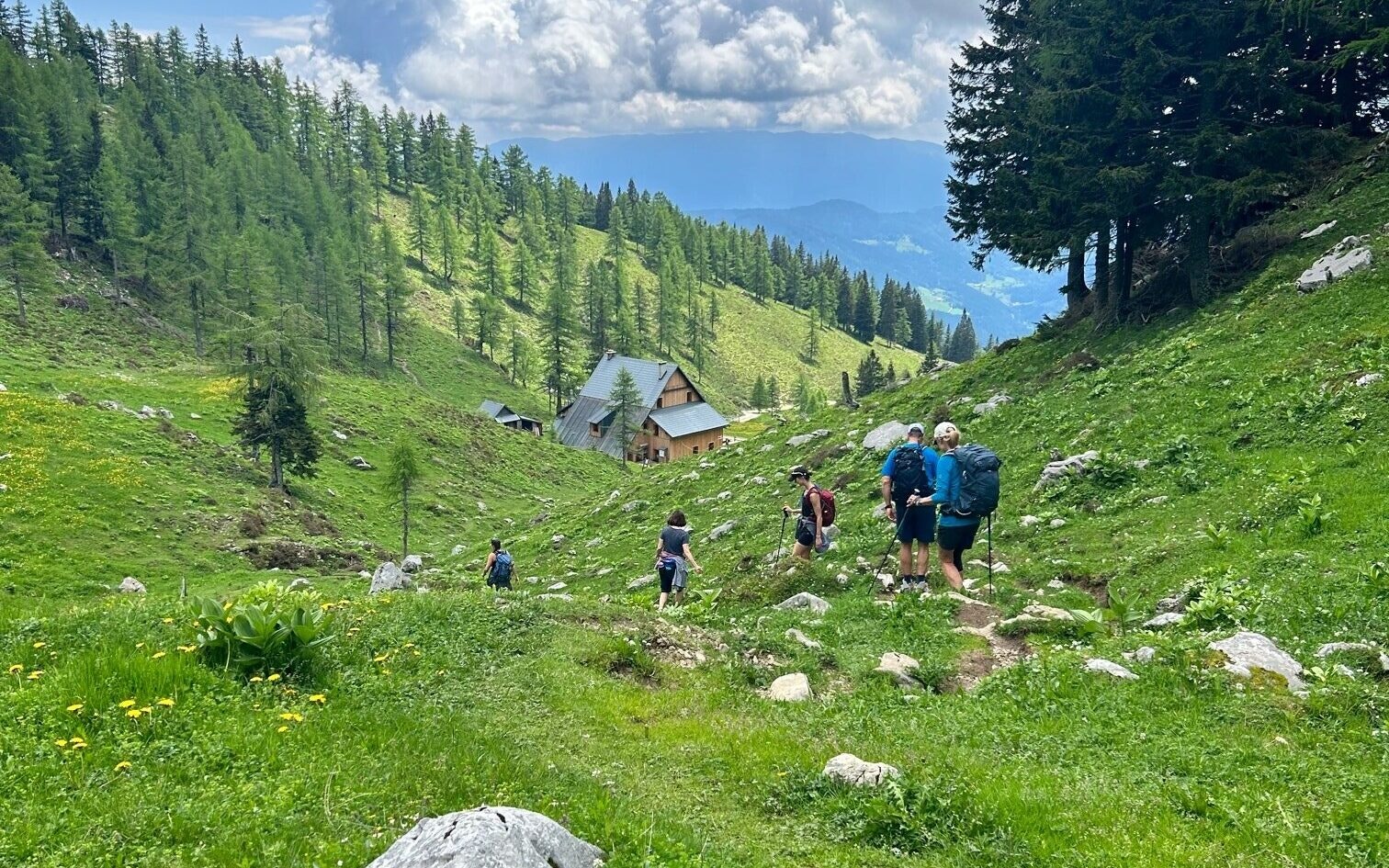
What are the best Slovenia adventure tours?
1. Slovenia Julian Alps Hiking Tour
Small yet majestic, dreamy and unspoiled, Slovenia is one of Europe’s best-kept secrets. On this unique 10-day adventure, you’ll experience the charm of its picturesque capital Ljubljana before heading off to explore the serene valleys, picturesque medieval villages, and impressive mountains that make this a perfect destination for active adventurers. Follow exhilarating trails and soak up the wonders of western Slovenia’s alpine scenery, from the awe-inspiring Julian Alps to the turquoise Soca River, to the fairy-tale castle on Lake Bled. Along the way, sleep in well-appointed, charming hotels with spa amenities, and sample Slovenia’s delicious cuisine and luscious wines.
2. Croatia, Slovenia & Italy Village to Village Walking Tour
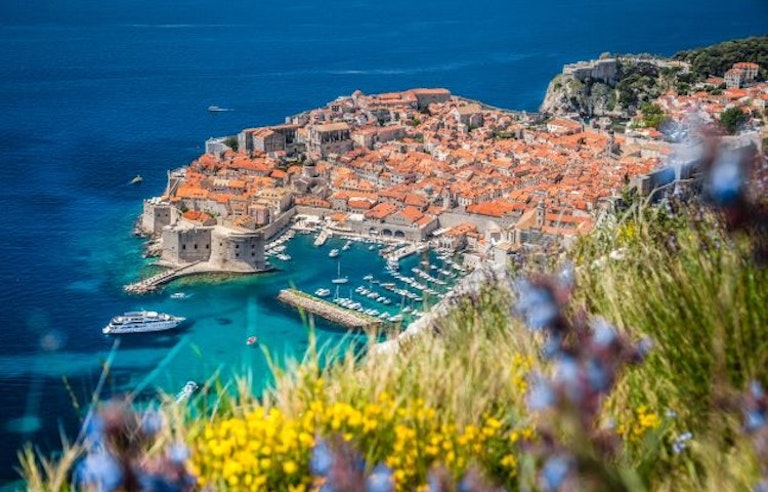
Food lovers! Reward fulfilling days on spectacular trails by raising your taste buds to the next level on this active nine-day cultural and culinary journey. Trace Croatia’s Istrian Peninsula, Slovenia’s Julian Alps, and Italy’s Friuli-Venezia-Giulia region and discover an array of beautiful villages and towns including Rovinj, Bale, Motovun, Groznjan, Bled, and Montemaggiore. Discover the wonders of this trio of countries, experiencing rich historical settings and spectacular national parks on awe-inspiring hikes. Go wine tasting, learn how to hunt truffles, taste olive oil, and sample regional delicacies in the Mediterranean as you’ve never seen it before, far from the crowds. Unique hotels awaiting at the end of each day make for a dreamy finale.
View Croatia, Slovenia, & Italy Village to Village Walking Tour
3. Austria, Italy & Slovenia Alpe Adria Hiking Tour
Experiencing all three Himalayan kingdoms in one journey is a rare feat, but MT Sobek’s 50 years of expertise in the Himalaya puts this odyssey within easy reach. Blending cultural discovery with moderate high altitude hiking, this exclusive itinerary goes deep into the heart of Bhutan, Nepal and Tibet – beautifully showcasing unspoiled Buddhist cultures. Along the way, discover Bhutan’s rich traditions; explore Kathmandu’s elaborate temples, stupas, and bazaars; and marvel at Tibet’s remote monasteries and the holy city of Lhasa. This incredible line-up of each kingdom’s must-see destinations can’t be missed!
4. Balkans Via Dinarica Hiking Tour
On this multi-country trek on one of Europe’s least-explored mountain ranges, the Dinaric Alps, discover rich cultures and spellbinding landscapes of the Western Balkans. From Slovenia’s capital, Ljubljana, across Croatia, Bosnia and Herzegovina, Montenegro, Kosovo and down to Albania—the 1,200-mile-long Via Dinarica is every hiker’s dream come true. Raft whitewater rapids down Europe’s largest canyon, marvel at old-growth forests and glacier-fed lakes, dip into the royal-blue Adriatic Sea, and tour Sarajevo’s nostalgic old town. On this epic three-week adventure, the most challenging part is bidding farewell to the beautiful Balkans.
Where are the best places to stay in Slovenia?
Accommodations in Slovenia vary depending on your budget and where you plan to stay. You can find everything from hostels and budget hotels to luxury resorts and apartments. Farm stays, castles, villas, and glamping options are also available, and hostels can be found throughout the country.
1. Hotel Bohinj: Lake Bohinj, Slovenia
Ideally located in a natural and scenic setting, the Hotel Bohinj is a short stroll from Bohinj Lake. Guestrooms have mountain views, hardwood floors, and are decorated with alpine-style furniture. Amenities in each unit include a safety deposit box, mini-bar, cable TV, and phone. A lush garden offers a place for relaxation after a long hike.
2. Hotel Triglav-Bled: Lake Bled, Slovenia
3. Hotel Gredič-Goriska Brda: Goriška, Slovenia
Set in a 16th-century castle, the luxury Hotel Gredič sits in the heart of Slovenia’s Brda wine country. The individually decorated guest rooms feature a range of amenities like Wi-Fi, A/C, and private bathrooms with heated floors. The on-site restaurant serves local specialties, the bar offers drinks and snacks, and there’s a terrace with views of the surrounding vineyards.
Interesting Things to Know About Slovenia
- Slovenia is one of the world’s most sustainable countries. With over 60% of the country covered in forests, 1,600 miles of rivers and lakes, and 9,700 named mountains, more than half the country is protected. According to The Good Country Index, Slovenia is the fourth best country for sustainable initiatives that address climate sustainability. The country also lists over 2,000 protected areas, ensuring that its landscape is maintained for future generations.
- The country is ablaze with bonfires every April 30. What used to be an event honoring workers’ rights, is now a country-wide social celebration. Towns and villages across the country light up bonfires, with the largest bonfires held on Rožnik Hill in Ljubljana and in the small town of Ruše, which is near the city of Maribor.
- Slovenians love wine. The country has almost 30,000 wineries, 2,500 wine producers, and produce approximately 90 million liters of wine a year, 70% of which is white wine. In the city of Maribor, the country’s second largest city, the oldest grapevine in the world—400 years—still produces grapes. Nowadays, despite a history of making wine since 400 BC, the country is finally seeing more wine tourism, with boutique, family-owned wineries opening their doors to travelers in the most prominent wine regions of Podravska, Pimorska, and Posavska, which are in the eastern half of the country.
- Slovenia has over 11,000 beekeepers, which is five out of every 1,000 people. Beekeeping goes back multiple generations in Slovenia and is seen as one of the country’s most important agricultural activities. The country also supports beekeeping tours, giving travelers the opportunity to learn more about the honey-making process, learn about bee apiaries, and discover what types of products are made from the Carniolan bees that produce their honey. There’s even a bee museum—the Museum of Apiculture in the city of Radovljica’s Old Town.
What is the language in Slovenia?
Slovenian (or Slovene) is the official language in Slovenia, but Italian on the Primorska coastline and Hungarian in the northern Prekmurje region are also predominant. English is spoken by a large percentage of people, and it is estimated that there are 50 Slovenian dialects, some of which are indistinguishable from each other.
What to eat in Slovenia?
Slovenian cuisine is abundant and diverse, and is influenced by local natural resources, tradition, and neighboring countries Austria, Italy, Croatia, and Hungary. Despite a popular myth that Eastern European cuisine is basic, Slovenia enjoys a rich and varied selection of produce (such as wild berries, potatoes, leeks, and olives), and meats (including pork, wild boar, goat, goose, turkey, duck, chicken, quail, and sea and freshwater fish). Mushrooms and herbs are also abundant, and dishes are often seasoned with local wildflowers. Slovenia is also known for its excellent wines, which are produced in the country’s many vineyards. One of its most popular wines is Teran, a dark red wine from the Karst region.
Some of the country’s most iconic dishes include kranjska klobasa, which is similar to Polish sausage, potica (a rolled pastry usually filled with walnuts), prekmurska gibanica (a pastry filled with poppyseeds, walnuts, apples, raisins, and a quark filling, which is similar to dried curds), kraški pršut (dry-cured ham similar to prosciutto), and štruklji (boiled or baked dough filled with sweet or savory fillings).
What is the currency in Slovenia?
Slovenia is a member of the EU, so its official currency is the Euro (EUR). Major hotels and shops in large cities accept credit cards, but cash is the preferred currency in smaller establishments and towns. Make sure to have cash on hand when visiting the countryside or when visiting off-the-beaten-path locations.
What is the electricity in Slovenia?
The electrical current in Slovenia is 230 volts, 50 Hz. The plugs and sockets used in Slovenia are type F. Check the voltage on your personal electronics chargers to determine if you need a voltage converter, but most US travelers will need a converter as US electronics are 110-120V (type A or B outlets).
A good resource to see images of plug types is www.power-plugs-sockets.com.
What is the time zone in Slovenia?
The time zone in Slovenia is Central European Time (CET) Mean Time, which is six hours ahead of New York and nine hours ahead of California.
What to wear in Slovenia?
When visiting Slovenia, it’s likely you’ll be having outdoor adventures, so you’ll need to plan according to your activities. When hiking in any mountainous area, be prepared for full sun, wind, rain, or even light snow. As soon as you move down the mountains, the weather will change. It’s not uncommon to begin the day in a t-shirt and “layer up” as you reach the higher elevations. Therefore, dress in layers to stay comfortable throughout the day.
Your outermost layer should keep you dry, such as a waterproof, breathable rain jacket and rain pants. Your mid layer should keep you warm, such as a wool pullover or fleece sweater/vest, and hiking pants, while your inner layer should wick moister, and also act as your warm-weather layer, such as synthetic t-shirts and shorts. Wearing cotton/denim garments is strongly discouraged in cold or wet conditions. On hot, sunny days, cotton is perfectly acceptable, but always have synthetic or wool/synthetic layers with you in case the weather changes. Have comfortable hiking or walking shoes, bathing suits if visiting the coast, and a nice pair of khakis or a dress for evenings out.
